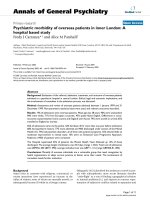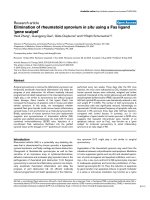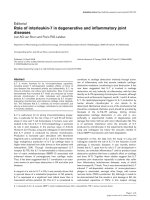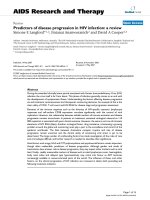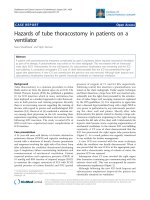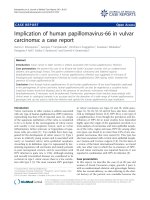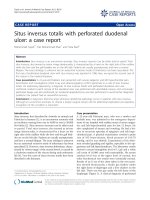Báo cáo y học: " Implication of human papillomavirus-66 in vulvar carcinoma: a case report" potx
Bạn đang xem bản rút gọn của tài liệu. Xem và tải ngay bản đầy đủ của tài liệu tại đây (2.8 MB, 5 trang )
CAS E REP O R T Open Access
Implication of human papillomavirus-66 in vulvar
carcinoma: a case report
Ioannis C Kotsopoulos
1*
, Georgios P Tampakoudis
1
, Dimitrios G Evaggelinos
1
, Anastasia I Nikolaidou
2
,
Panagiota A Fytili
3
, Vasilios C Kartsiounis
1
and Domniki K Gerasimidou
2
Abstract
Introduction: Vulvar cancer in older women is seldom associated with human papillomavirus infection.
Case presentation: We present the case of an 80-year-old Greek Caucasian woman with an undetermined
obstetric and gynecologic history. The patient underwent radical vulvectomy and bilateral inguinal
lymphadenectomy for a vulvar carcinoma. A human papillomavirus infection was suggested on the basis of
histological and cytological examinations followed by human papillomavirus DNA typing, which revealed the
presence of human papillomavirus-66.
Conclusion: Even though human papillomavirus-16 and human papillomavirus-18 are most frequently implicated
in the pathogenesis of vulvar carcinoma, human papillomavirus-66 can also be regarded as a causative factor.
Suspicious lesions should be biopsied, and in the presence of carcinoma, vulvectomy with bilateral
lymphadenectomy, if necessary, must be performed. Furthermore, polymerase chain reaction assay analysis with
clinical arrays in cytological samples is an accurate test for the detection of a wide range of human papillomavirus
genotypes and can be used to verify the infection and specify the human papillomavirus type implicated.
Introduction
Vulvar carcinoma in older women is seldom associated
with any type of huma n papillomavirus (HPV) infection,
representing less than 15% of reported cases [1]. Atypia
of the squamous epithelium of the vulva is considered
to be a co-factor in the carcinogenesis of vulvar cancer
and usually a non-neoplastic lesion, such as vulvar
inflammation, lichen sclerosus or hyperplasia of squa-
mous cells, pre-exists [1]. Two models have been sug-
gested for the development of vulvar cancer [1]. Type 1
occurs in relatively young women and is associated with
warty or basaloid vulvar intra-epithelial neoplasia.
According to its definition, type 2 is represented by ker-
atinizing squamous cell carcinoma and m ainly presents
in post-menopausal women, and its association with
HPV infection is quite rare (< 15%). Although smoking
and sexually t ransmitted diseases are considered to be
co-factors in type 1 vulvar cancer, there is a low correla-
tion with type 2 [1]. The most common HPV genotypes
in vulvar carcinoma are types 16 and 18, while geno-
types 31, 33, 45, 52, 53 and 62 have also been consid-
ered as etiological factors [2-5]. HPV-66 is a rare type of
a-papillomavirus. Even though the prevalence and dis-
tribution of HPV-66 in most studies have depended
highly upon the origin of the po pulation involved, in a
meta-analysis of carcino mas and intra-epithelial neopla-
sia of the vulva, vagina and anus, HPV-66, among other
rare types, was found in no more than 0.5% of any ano-
genital carcinomas that were tested [6]. This type has
also been associated with cervical intra-epithelial neopla-
sia 1 lesions and Verruca vulgaris [7,8]. On the basis of
a review of the latest international literature, we found
only one other case in which the co-existence of HPV-
66 and vulvar carcinoma was reported; however, it was
reported in combination with HPV-52 infection [9].
Case presentation
In this report, we describe the case of an 80-year-old
woman of Greek Caucasian o rigin, gravida 2 para 2,
with an undetermined obstetric and gynecologic history.
After her second delivery, no dat a referring to the clini-
cal history of the patient was available because the
* Correspondence:
1
Gynecological Oncology Department, “Theagenio ” Cancer Hospital, 2 Alex.
Simeonidis Street, Thessaloniki, 54007, Greece
Full list of author information is available at the end of the article
Kotsopoulos et al. Journal of Medical Case Reports 2011, 5:232
/>JOURNAL OF MEDICAL
CASE REPORTS
© 2011 Kotsopoulos et al; licensee BioMed Central Ltd. This is an Open Access article distrib uted under the term s of the Creative
Commons Attribution License ( which permits unrestricted use, distribution, and
reproductio n in any me dium, pr ovided the original work is properly cited.
patient deferred any preventive or diag nostic medical
examination until she presented to our hospital. Her last
men strual period had occurred 28 years ago. Her medi-
cal history included hypertension and angina pectoris.
The patient was examined in the gynecological oncol-
ogy outpatient department and w as found to have
chronic pruritus vulvae and a recent onset palpable
inflammatory lesion on the left labium majus. The lesion
bled occasionally. During her gynecological examination,
a4cm×5cmwartylesionwithulcerousandhemor-
rhagic areas (Figure 1) was found in the middle of the
left labium majus.
Initially, multiple biopsies from the center of the lesion
and from the lateral margins were obtained, the histologi-
cal examination of which revealed the presence of squa-
mous cell carcinoma. At the periphery of the lesion, the
squamous stratified epithelium exhibited abnormalities
consistent with vulvar intra-epithelial neoplasia (vulvar
intra-epithelial neoplasia (VIN) grade I/II). Numerous
lesional cells showed koilocytic atypia, which is representa-
tive of HPV-related infection. However, initial hybrid cap-
ture 2 testing for HPV was negative in all the samples
tested, which were obtained from either the center or
the periphery of the lesion. A pre-operative computed
tomographic scan of the abdomen and inguinal areas
showed bilaterally enlarged inguinal lymph n odes with
central fusion.
The patient underwent radical vulvectomy extending
centrally to the level of the perineal membrane, as well
as bilateral inguinal lymphadenectom y. Post-operati vely,
the woman had no major complications and was dis-
charged 14 days after the procedure.
A histopathological examination o f the excised speci-
men verified the presence of squamous cell carcinoma
grad e II/III with superficial ulcerations (Figures 2 and 3).
Carcinoma cells invaded the stroma and the underlying
adipose tissue with irregular invasive margins. The full
thickness of the lesion from the surface to the deepest
point was 1.2 cm. As noted regarding the pre-operative
biopsies, the adjacent squamous stratified epithelium
exhibited VIN grades I and II lesions (Figure 4). Further-
more, metastases of the squamous cell carcinoma invol-
ving two of 11 right inguinal lymph nodes and two of five
left inguinal lymph nodes were found. The vulvar lesion
was excised within normal tissues.
In the tissue specimen obtained pre-operatively for the
performance of liquid-based Cytology (The Thin prep -
pap test, Cytyc Corp., Marborough, Massachusetts, USA),
we used a polymerase chain reaction (PCR) assay with
CLINICAL ARRAYS Human Papillomavirus Kit
Figure 1 Preoperative image of the lesion. Α 4 cm × 5 cm warty
lesion is present on the left labium majus of the vulva.
Figure 2 Mod erately differentiated architectural and cytologic
appearance of squamous cell carcinoma among mildly
desmoplastic stroma (hematoxylin and eosin stain; original
magnification, ×100).
Figure 3 Koilocytic changes in vulvar squamous epithelium
consistent with HPV infection (hematoxylin and eosin stain;
original magnification, ×200).
Kotsopoulos et al. Journal of Medical Case Reports 2011, 5:232
/>Page 2 of 5
(Genomica, Madrid, Spain) and a Hybrid Capture 2
HPV DNA test (Digene, Madrid, Spain). The latter test
is an accurate qualitative and quantitative method used
to detect five low-risk types of HPV (6, 11, 42, 43 and
44) and 13 high-risk types of HPV (16, 18, 31, 33, 35,
39, 45, 51, 52, 56, 58, 59 and 68). It can also determine
the viral load. This technology is based on hybrid analy-
sis to identify indentifying a signal enhancement in a
microplate using chemiluminescence. Samples contain-
ing the target DNA are hybridized with a specific detec-
tor HPV RNA. Hybrid-produced RNA-DNA binds to
the surface of a microplate coated with s pecific antibo-
dies for RNA-DNA hybrids. The immobilized hybrids
react with alkaline phosphatase (ALK)-conjugated a nti-
bodies and are detected with a chemil uminescence sub-
strate. While the binding ALK cleaves the substrate, it
attracts light, which is measured by chemiluminescence
in relative light units [10].
For the purpose of this study, we also used the CLINI-
CAL ARRAYS H uman Papillomavirus Kit (Genomi ca,
Madrid, Spain), which is a commercially available HPV
genotyping microarray test (Figure 5). The kit was used
according to the manufacturer’ sprotocol.Weused10
μL of purified DNA for each specimen. The kit employs
biotinylated primers to define a sequence of 451 nucleo-
tides within the polymorphic L1 region of the HPV gen-
ome. A pool of HPV primers is used to amplify HPV
DNA from 35 mucosal genotypes, including 15 high-risk
genotypes (16, 18, 31, 33, 35, 39, 45, 51, 52, 56, 58, 59,
68, 73 and 82), three potentially high-risk genotypes
(26, 53 and 66), 11 low-risk genotypes (6, 11, 40, 42, 43,
44, 54, 61, 70, 72 and 81) and six genotypes of unknown
risk (62, 71, 83, 84, 85 and 89). In addition to the
microarray analysis, PCR was performed with the HPV
consensus primers MY09 and MY11 (18). PCR was per-
formed consecutively as follows: 95°C for 15 minutes
and 40 cycles of 94°C for 15 seconds, 52°C for 30 sec-
onds and 72°C for 45 seconds [11].
In our case, none of the above-mentioned HPV types
was detected with the use of hybrid capture 2 testing.
The DNA of HPV-66 was the only one detected using
the CLINICAL ARRAYS Human Papillomavirus Kit.
On the basis of these results, a standard PCR assay
was also performed. Four histological specimens from
four different levels of the lesion, as well as from a
lymph node with metastasis, were examined. Extraction
of total DNA from formalin fixed, paraffin-embedded
sections was performed using the QIAamp DNA Mini
Kit (Qiagen, Hilden, Germany) according to the manu-
facturer’ s instructions. The quality and integrity of
extracted DNA were assessed by PCR amplification of
an amplico n of the interferon (IFN)-g gene and by agar-
ose gel (0.6%) electrophoresis, respectively. A nested,
multiplex, highly sensitive PCR method (approximately
1 fg/103 viral copies) was used for HPV detection and
genotyping. In this assay, consensus primers for first-
run amplification of a broad spectrum of mucosal HPV
genotypes, including all high -risk HPV genotypes, were
combined with nested PCR amplifications of type-spe-
cific primers. Despite robust detection of the IFN-g
Figure 4 Vulvar intra-epithelial neoplasia (VIN grade I) adjacent
to carcinoma (hematoxylin and eosin stain; original
magnification, ×100). There is proliferation and atypia of the lower
third, but surface maturation is evident. The stroma is heavily
infiltrated.
Figure 5 The CLINICAL ARRAYS Human Papillomavirus Kit was
used for HPV typing. The combination of the three dark diagonal
points indicates the presence of HPV-66 typing. The other, less
prominent dots represent control markers.
Kotsopoulos et al. Journal of Medical Case Reports 2011, 5:232
/>Page 3 of 5
gene product amplification, no positive signal for HPV
presence was found in any of the examined samples,
even after substantially increasing the PCR cell cycles.
Considering that there were clear indications of HPV
infection in the microscopic examination of the speci-
mens, the PCR assay was unable t o detect the DNA of
the virus, most probably because of low viral load in
the specimens examined, which could have been
caused and amplified b y inadequate superficial lesional
tissue. Furthermore, tissue fixation techniques could
have a negative impact on the preservation of the viral
genome.
Discussion
The presence, coexistence and possible cause of HPV
infection in women’ s anogenital squamous neoplasia
have been studi ed extensively over the past decade. It
must be emphasized that the presence of condylomatous
lesions does not exclude the possibility of a coexisting
invasive malignancy. However, the correlation appears
to be stronger as far as intra-epithelial lesions (VIN
grade III) are concerned.
HPV-66 is an a-papillo mavirus considered to belong
among the potentially high-risk mucosal HPV types.
Nevertheless, it can also b e enc ountered in benign
lesions. Even though this HPV type is report ed to be
associated with cervical squamous carcinomas, little is
known con cerning vulvar squamous cell carcinomas. On
the other hand, vulvar carcinom as are mainly correlated
with HPV-16 and 18 genotypes. In our case report, we
describe the case of a woman with a HPV-66-related
vulvar carcinoma. This diagnosis was made on the basis
of the use of PCR with the CLINICAL ARRAYS Human
Papillomavirus Kit.
Conclusion
In conclusion, in patients with HPV-66 infection the
possibility of a coexisting invasive malignancy, albeit
rare, should be considered even in the presence of
benign lesions. Caution should be taken, especially in
older women with cancer, as t he majority of these can-
cers are HPV-negative. In cases that raise clinical sus-
picions of HPV, examination of tissue using PCR with
the CLINICAL ARRAYS Human Papillomavirus Kit
should be considered in patients with histological fea-
tures of HPV infection and negative Hybrid Capture 2
assay testing, as it detects a wider range of HPV geno-
types than other types of testing, including HPV-66. A
standard PCR assay of formalin-fixed samples seemed
to be less effective, as it appeared to be affected by
sampling, tissue fixation and/or vi ral load. Patients
should be followed up meticulously at short time
intervals.
Consent
Written informed consent was obtained from the patient
for publication of this case report and accompanying
images. A copy of the written consent is available for
review by the Editor-in-Chief of this journal.
Acknowledgements
We recognize Dr Kartsiounis Christos for his help in using data from
gynecological oncology department archives, Mr Mousidis Ioannis for
photographing the histopathological images and Mr Kotsinas Athanassios
and Dr Gorgoulis Vasilios of the University of Athens for performing PCR
assays in formalin-fixed samples, as well as Dr Destouni Chariklia for her
consultation in interpreting the cytological and PCR results.
Author details
1
Gynecological Oncology Department, “Theagenio ” Cancer Hospital, 2 Alex.
Simeonidis Street, Thessaloniki, 54007, Greece.
2
Pathology Department,
“Theagenio” Cancer Hospital, 2 Alex. Simeonidis Street, Thessaloniki, 54007,
Greece.
3
Cytology Department, “Theagenio” Cancer Hospital, 2 Alex.
Simeonidis Street, Thessaloniki, 54007, Greece.
Authors’ contributions
IK conceptualized the case report, collected and analyzed all data and wrote
the major part of the manuscript. GT corrected the initial manuscript and
wrote parts of the manuscript. DE was the major gynecologist (in
cooperation with IK and GT) who cared for and conducted patient follow-
up. DG and AN performed the histological examinations and corrected the
pathological parts of the manuscript. Also, DG wrote parts of the manuscript
and gave final approval of the manuscript. PF performed the HPV typing
(Hybrid Capture 2 assay and CLINICAL ARRAYS Human Papillomavirus Kit
testing) and corrected the cytological parts of the manuscript. VK reviewed
the literature and wrote some parts of the Introduction. All authors read and
approved the final manuscript.
Competing interests
The authors declare that they have no competing interests.
Received: 18 June 2010 Accepted: 25 June 2011
Published: 25 June 2011
References
1. Schorge JO, Schaffer JI, Halvorson LM, Hoffman BL, Brandshaw KD,
Cunningham FG: Invasive cancer of the vulva. Williams Gynecology New
York: McGraw-Hill Medical; 2008, 665-668.
2. Smith JS, Backes DM, Hoots BE, Kurman RJ, Pimenta JM: Human
papillomavirus type-distribution in vulvar and vaginal cancers and their
associated precursors. Obstet Gynecol 2009, 113:917-924.
3. Sutton BC, Allen RA, Moore WE, Dunn ST: Distribution of human
papillomavirus genotypes in invasive squamous carcinoma of the vulva.
Mod Pathol 2008, 21:345-354.
4. Venuti A, Marcante ML: Presence of human papillomavirus type 18 DNA
in vulvar carcinomas and its integration into the cell genome. J Gen Virol
1989, 70:1587-1592.
5. Insinga RP, Liaw KL, Johnson LG, Madeleine MM: A systematic review of
the prevalence and attribution of human papillomavirus types among
cervical, vaginal, and vulvar precancers and cancers in the United States.
Cancer Epidemiol Biomarkers Prev 2008, 17:1611-1622.
6. De Vuyst H, Clifford GM, Nascimento MC, Madeleine MM, Franceschi S:
Prevalence and type distribution of human papillomavirus in carcinoma
and intraepithelial neoplasia of the vulva, vagina and anus: a meta-
analysis. Int J Cancer 2009, 124:1626-1636.
7. Wu D, Cai L, Huang M, Zheng Y, Yu J: Prevalence of genital human
papillomavirus infection and genotypes among women from Fujian
province, PR China. Eur J Obstet Gynecol Reprod Biol 2010, 151:86-90.
8. Davis MD, Gostout BS, McGovern RM, Persing DH, Schut RL, Pittelkow MR:
Large plantar wart caused by human papillomavirus-66 and resolution
by topical cidofovir therapy. J Am Acad Dermatol 2000, 43:340-343.
Kotsopoulos et al. Journal of Medical Case Reports 2011, 5:232
/>Page 4 of 5
9. van de Nieuwenhof HP, van Kempen LC, de Hullu JA, Bekkers RL, Bulten J,
Melchers WJ, Massuger LF: The etiologic role of HPV in vulvar squamous
cell carcinoma fine tuned. Cancer Epidemiol Biomarkers Prev 2009,
18:2061-2067.
10. Dutra I, Santos MR, Soares M, Couto AR, Bruges-Armas M, Teixeira F,
Monjardino L, Hodgson S, Bruges-Armas J: Characterisation of human
papillomavirus (HPV) genotypes in the Azorean population, Terceira
island. Infect Agent Cancer 2008, 3:6.
11. García-Sierra N, Martró E, Castellà E, Llatjós M, Tarrats A, Bascuñana E, Díaz R,
Carrasco M, Sirera G, Matas L, Ausina V: Evaluation of an array-based
method for human papillomavirus detection and genotyping in
comparison with conventional methods used in cervical cancer
screening. J Clin Microbiol 2009, 47:2165-2169.
doi:10.1186/1752-1947-5-232
Cite this article as: Kotsopoulos et al.: Implication of human
papillomavirus-66 in vulvar carcinoma: a case report. Journal of Medical
Case Reports 2011 5:232.
Submit your next manuscript to BioMed Central
and take full advantage of:
• Convenient online submission
• Thorough peer review
• No space constraints or color figure charges
• Immediate publication on acceptance
• Inclusion in PubMed, CAS, Scopus and Google Scholar
• Research which is freely available for redistribution
Submit your manuscript at
www.biomedcentral.com/submit
Kotsopoulos et al. Journal of Medical Case Reports 2011, 5:232
/>Page 5 of 5
